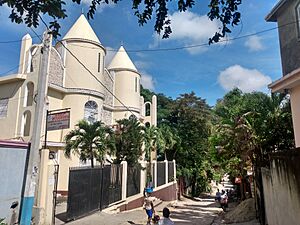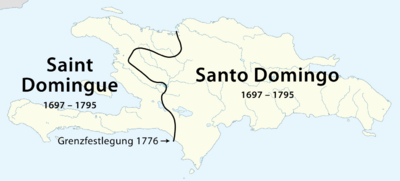Hinche facts for kids
Quick facts for kids
Hinche
Ench
|
|
|---|---|
|
Commune
|
|

Cathédrale de Sacré-Coeur in Hinche
|
|
| Nickname(s):
La Cité de Charlemagne Peralte
The City of Charlemagne Peralte |
|
| Country | |
| Department | Centre |
| Arrondissement | Hinche |
| Founded in | 1704 |
| Elevation | 228 m (748 ft) |
| Population
(7 August 2003)
|
|
| • Commune | 102,745 |
| • Metro | 50,000 |
| Time zone | UTC-5 (Eastern) |
| • Summer (DST) | UTC-4 (Eastern) |
Hinche (pronounced "Ench") is a city in Haiti. It is the capital of the Centre department. About 50,000 people live there. Hinche is the hometown of Charlemagne Péralte. He was a Haitian leader who fought against the United States occupation of Haiti from 1915 to 1934.
Contents
History of Hinche
![]() Spanish Empire 1704–1801
Spanish Empire 1704–1801
![]() France 1801–1809
France 1801–1809
![]() Spanish Empire 1809–1821
Spanish Empire 1809–1821
![]() Republic of Spanish Haiti 1821–1822
Republic of Spanish Haiti 1821–1822
![]() Haiti 1822–1844
Haiti 1822–1844
![]() Dominican Republic 1844–1937
Dominican Republic 1844–1937
![]() Haiti 1937–present
Haiti 1937–present
Early Colonial Times
The island of Hispaniola was found by Christopher Columbus in 1492. The original people, the Tainos, slowly disappeared because of the Spanish conquistadors.
The village of Hincha, which is now Hinche, was started in 1704. Spanish settlers from the Canary Islands founded it.
By 1739, about 500 people lived there. This number grew to over 3,000 by 1760, including many enslaved people. The city's economy mainly focused on selling beef to the nearby French colony of Saint-Domingue. Beef was much more expensive there.
In 1777, Spain and France signed a treaty. This treaty set the border between their colonies on the island. Hinche was on the Spanish side.
Changes in Control
Hinche saw fighting during the War of the First Coalition. After this war, Spain gave all its rights over Hispaniola to France. This was part of the Peace of Basel treaty.
France did not take full control until 1802. In 1801, during the Haitian Revolution, Toussaint Louverture took over Santo Domingo. He declared that enslaved people were free. Later, Napoleon Bonaparte sent an army. They captured Louverture and sent him to France. In 1809, Spain got its lands back, and slavery was brought back.
From 1821 to 1937
On December 1, 1821, the Republic of Spanish Haiti declared its independence. Soon after, Jean Pierre Boyer from Haiti took over the Spanish side of the island. Haiti ruled the whole island for 22 years.
In 1844, the former Spanish Haiti became the independent Dominican Republic. Towns like Hinche (then Hincha) were isolated. They had little contact with the Dominican capital. Haitian influence grew, and both Spanish and Haitian Creole were spoken. These cities were often argued over by Haiti and the Dominican Republic.
Hinche is the hometown of Pedro Santana, the first President of the Dominican Republic. It is also where Charlemagne Péralte was born. He was a Haitian leader who fought against the US occupation of Haiti (1915–1934).
Recent Events
On March 18, 2016, a fuel truck exploded in Hinche. At least 7 people died and 30 were hurt. Four homes and 22 vehicles were also destroyed in the accident.
Culture and Life in Hinche
Religion and Community
The main religion in Hinche is Roman Catholicism. However, people are free to choose their religion. Many other Christian churches are also in the city. Groups like the Haiti Endowment Fund (HEF) help by sending medical teams. They provide medicine and basic healthcare. Some people also practice Vodou.
Local Cuisine
The food in Hinche is a mix of Créole and French styles. Créole food is similar to other Caribbean dishes but often spicier. Some special dishes include:
- Griot: Deep-fried pork pieces.
- Lambi: Conch, a type of shellfish.
- Tassot: Jerked beef.
- Rice with djon-djon: Rice cooked with tiny, dark mushrooms.
Like in other parts of the Caribbean, lobster is also popular. The area has many different fruits and vegetables. People enjoy strong, sweet coffee, and Barbancourt rum is also well-liked.
Hinche has a lively market. There is also a guesthouse called "Foyer d’Accueil" above a school. It is behind a blue and white church near the main square.
After the 2010 Earthquake
On January 12, 2010, a big earthquake hit Haiti. Hinche did not have many casualties or serious damage. However, thousands of people who lost their homes in other areas came to Hinche for safety.
Places to Visit
You can get to Hinche by road or by plane. The city has an airport with a dirt runway. Small planes like a Cessna can land there. These flights are usually chartered from Port-au-Prince. Mission Aviation Fellowship also offers charter flights to Hinche. Before a plane lands, people and animals must be moved off the runway. The airport is very close to the city center and right across from the hospital.
East of Hinche, you can find Bassin Zim. It is a 20-meter (65-foot) waterfall in a green area. It's about a 30-minute drive from town. In the city, you can also visit the Cathédrale de Sacré-Coeur.
Getting Around Hinche
Route Nationale 3 is a main road that goes from Port-au-Prince to Hinche. It is 128 kilometers (about 80 miles) long. This road is now fully paved. It used to be a dirt road and needed a four-wheel-drive vehicle. The trip would take at least two hours.
The road passes through the Cul-de-Sac plain and Croix-des-Bouquets. Another road, Route Nationale 8, branches off southeast. It goes through a dry area, past Lake Saumâtre, to the Dominican border at Malpasse.
Route Nationale 3 then heads north into the Central Plateau. This area saw many changes after the 1991 Haitian coup d'état. The road also passes the Peligre Hydroelectric Dam and the town of Thomonde before reaching Hinche.
Media in Hinche
Radio Stations
- Radio Seven Stars
- Radio Leleonline FM
- Radio Super Continentale
- Radyo Leve Kanpe
- Radyo Vwa Peyizan
- Radio Quotidien FM
- Radio Immaculée Conceptio
- Radio Centre Inter
- Radio CAST FM
- Radio Communautaire de Pandiassou
- Radio MEN FM
- Le Prince FM
- Radio Africa
- Radio Combat FM
Television Channels
- Télé Quotidien
- Tele Pam
- Tele Super Continentale
- Tele Seven Stars
- Tele Leve Kanpe
- Tele MEN
See also
 In Spanish: Hincha (ciudad) para niños
In Spanish: Hincha (ciudad) para niños



